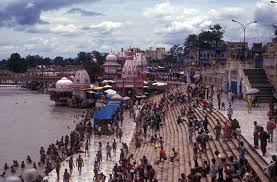
We have started to travel uphill, from Tiruppiridi. First we come across Vishnu Prayag. Route is zig zag. On one side we find steep hill and on the other side it is the dangerous steep ground below. Even a small careless driving can tumble the vehicle deep down below. But the drivers are quite skillful in driving. We allay our fears by chanting Gita and Vishnu Sahasranamam! We feel highly nervous when the vehicle crosses hair-pin bends in the road! We think that these drivers have understood Gita correctly! They say that Sri Badrnath is protecting them and they are confident that the journey will always be safe! In fact to get that confidence we are studying Gita and Sahasranamam! At Vishnu Prayag, is the confluence of rivers Vishnu Ganga and Alakananda. Here, sage Narada meditated for a long time. We can see one river is in mud color, while the other is in pale green color. It is like disturbed mind and clear mind. Can they come together? We should not see in that way. Normally, we have disturbed mind in worldly affairs; whereas our mind should be disturbed, when we hear stories of the Lord. We seem to be least disturbed when we hear Sri Krishna is threatened by demons. We should be clear of worldly affairs. Now, we further travel up and reach Pandukeshwar. Since we have to see many places here, we will spend more time while returning. Next, we reach Hanuman Chatti.

At this place Hanuman meditated. After this place is Badarikashram. At all these places traffic is regulated by gate system. All these places are controlled by Military personnel. Gates are opened at specific times only, enabling movement of vehicles. To reach Hanuman Chatti, we have to cross an iron bridge. When vehicles travel on this, we can hear thundering sounds! While going this sound can be interpreted as the reflection of our eagerness to worship Lord Sri Badrinath; and while returning, same sounds reflect our yearning for one more Darshan! We worship Hanuman to make our trip successful! After Hanuman Chatti, the journey is steeper! In 18KMs, we gain height by 1500 Metres or about 4500 Feet! Now we have arrived at the welcome arch of Badarikashram!

Our long awaited dream comes true! We will go inside after seeing sloka 13. In slokas 11, 12 and 13, the Lord tells about Satvika Yagna, Rajasa Yagna and Tamasa Yagna respectively. We will see Tamasa Yagna in sloka 13:
vidhihīnam asṛṣṭānnaṃ mantrahīnam adakṣiṇam
śraddhāvirahitaṃ yajñaṃ tāmasaṃ paricakṣate 17.13
That is Tamasa Yagna has, vidhi hinam = without rules. That is Yagna is performed not as prescribed or permitted by great Acharyas or Rishis or Bruhaspati. One should not do yagna as he liked. Asrstannam = with materilas not procured in honest ways. If we want to perform a Yagna, we need many people like Ritviks, Hota, Udgata, etc., and we have to provide them with proper Dakshina [remuneration]. We need materials for performing yagna and to feed the guests. It means expenditure. The money and materials for this expenditure must have been earned in honest ways. We can not perform Yagna to compensate for unethically earned wealth. It is not like in business, where set-off is practiced! Mantrahinam = mantras not properly or adequately chanted. All persons involved have to chant mantras sincerely. In marriages, these days, lots of money are spent. But the bridegroom would not have chanted mantras properly. What is the use of spending so much money? With Agni as witness, we should ensure that mantras are chanted and repeated properly. While all our friends and relatives would vanish by the next day, chanted mantras would always remain with us and protect us. In every such religious rites, we should take all out efforts to chant mantras sincerely. Adaksinam = by not giving the remuneration to various persons in the performance of Yagna. We can not perform Yagna without dakshina or remuneration. In holy places like Badarikashram, there are many noble persons performing meditation. People search for them and offer whatever is possible. Those persons never asked for anything. Sraddhavirahitam = without earnestness to perform. Saying that he had no interest but doing for others' sake or giving maney to perform yagna and not participating, are all in Tamasa Yagna. Yajnam = such Yagnas are, paricaksate = considered, tamasam = Tamasa type.

















 g He travels by
g He travels by 



